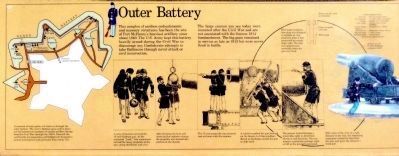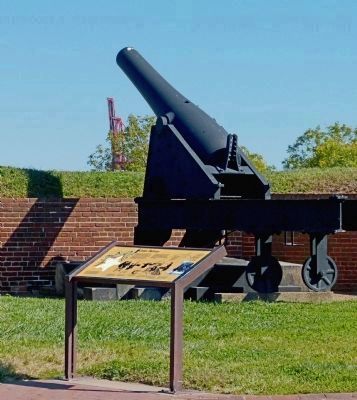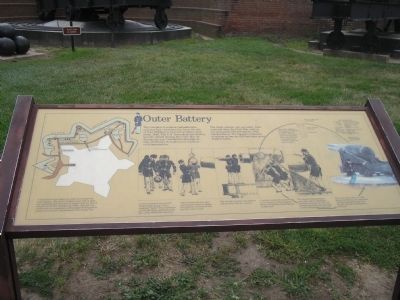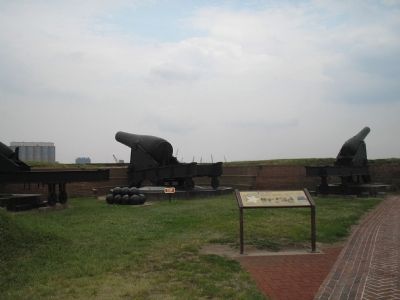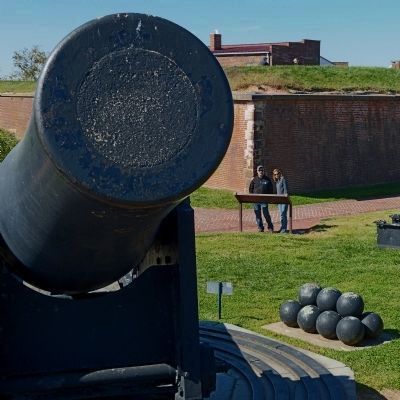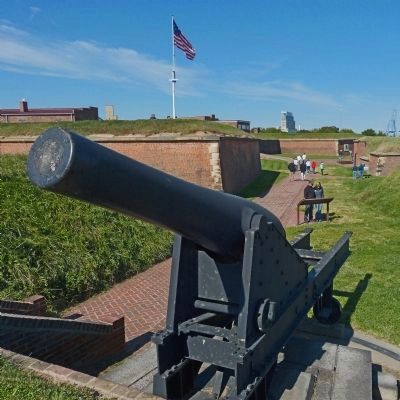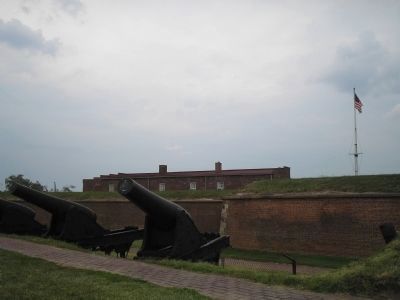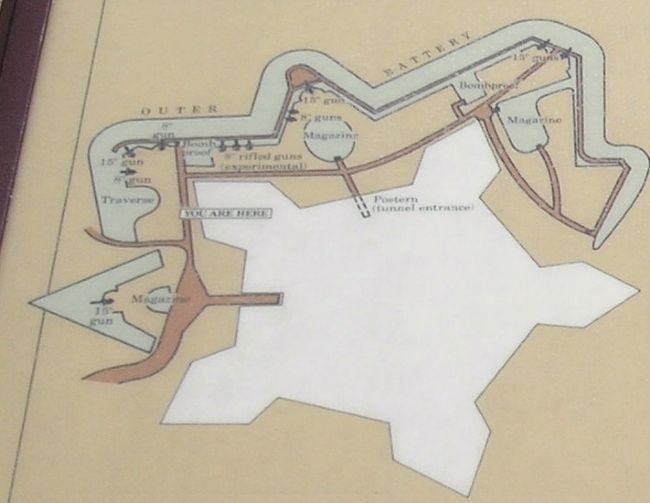Locust Point Industrial Area in Baltimore, Maryland — The American Northeast (Mid-Atlantic)
Outer Battery
This complex of earthen embankments and masonry structures has been the site of Fort McHenry’s heaviest artillery since about 1840. The U.S. Army kept this battery heavily armed during the Civil War to discourage any Confederate attempts to take Baltimore through naval attack or civil insurrection.
The large cannon you see today were mounted after the Civil War and are not associated with the famous 1814 bombardment. The big guns remained in service as late as 1912 but were never fired in battle.
Erected by National Park Service, U.S. Department of the Interior.
Topics and series. This historical marker is listed in these topic lists: Forts and Castles • War, US Civil. In addition, it is included in the Maryland, Fort McHenry series list. A significant historical year for this entry is 1840.
Location. Marker has been reported permanently removed. It was located near 39° 15.79′ N, 76° 34.738′ W. Marker was in Baltimore, Maryland. It was in the Locust Point Industrial Area. Marker was on East Fort Avenue, on the right when traveling east. Marker is on grounds of Fort McHenry National Monument. Touch for map. Marker was at or near this postal address: 2400 E Fort Ave, Baltimore MD 21230, United States of America.
We have been informed that this sign or monument is no longer there and will not be replaced. This page is an archival view of what was.
Other nearby markers. At least 8 other markers are within walking distance of this location. You Can Help Save Fort McHenry (here, next to this marker); The Great Guns of the Fort… The Rodman Cannons (a few steps from this marker); Experimental Carriages (a few steps from this marker); Dawn's Early Light (a few steps from this marker); Entering Fort McHenry … A Deadly Crossfire (within shouting distance of this marker); Ravelin Magazine (within shouting distance of this marker); Army "Sailors," Navy "Soldiers" (within shouting distance of this marker); The Guns that Won the Battle (within shouting distance of this marker). Touch for a list and map of all markers in Baltimore.
More about this marker. The left side of the marker contains a map of the Outer Battery, with the caption “A network of brick paths will lead you through the outer battery. The twelve Rodman guns still in place are well-preserved examples of coastal artillery dating from the Civil War through the 1890’s. Beneath the earthworks are magazines and bombproofs designed to protect ammunition and personnel from enemy fire.
The right side of the marker features a series of pictures depicting the steps necessary to load and fire a Rodman gun. They have a caption of “A crew of fourteen serviced the 15-inch Rodman gun. At the command ‘Load!,’ four cannoneers carried the heavy projectile to the gun, using shellhooks and a bar. After cleaning the bore and inserting the explosive charge, the projectile was hoisted into position at the muzzle. The 15-inch projectile was inserted and set home with a rammer. A ratchet cranked the gun forward on its chassis to firing position. Recoil at discharge caused the gun to slide back. The gunner looked through a removable sight to determine elevation and direction. The cannoneers rotate the carriage right or left at the gunner’s command. With most of the crew at a safe distance to the rear, the remaining cannoneers turned the face of the gun and gave the lanyard a brisk pull. The water resistant fuse plug was designed to explode an iron projectile after it first penetrated the enemy’s ship side. The fuse was ignited automatically when the gun was fired.”
Also see . . . Fort McHenry National Monument and Historic Shrine. National Park Service. (Submitted on August 30, 2008, by Bill Coughlin of Woodland Park, New Jersey.)
Credits. This page was last revised on April 20, 2022. It was originally submitted on August 30, 2008, by Bill Coughlin of Woodland Park, New Jersey. This page has been viewed 1,976 times since then and 79 times this year. Last updated on March 29, 2022, by Connor Olson of Kewaskum, Wisconsin. Photos: 1, 2. submitted on October 26, 2012, by Allen C. Browne of Silver Spring, Maryland. 3, 4. submitted on August 30, 2008, by Bill Coughlin of Woodland Park, New Jersey. 5, 6. submitted on October 26, 2012, by Allen C. Browne of Silver Spring, Maryland. 7, 8. submitted on August 30, 2008, by Bill Coughlin of Woodland Park, New Jersey. • J. Makali Bruton was the editor who published this page.
